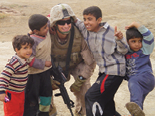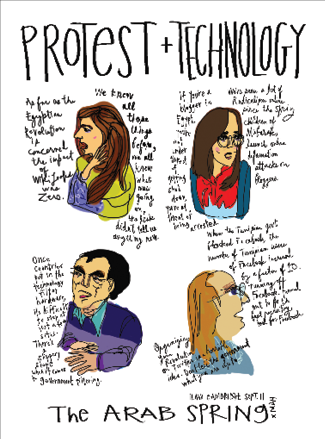First Person

Jonathan Margolick is all about community—finding it and living fully in it. And he thinks that his classmates at Stanford Law School make this very small community a most amazing one.
“I don’t know how the school chooses students, but it’s clear to me that they look for the people with the most interesting life experiences,” says Margolick, JD ’13. “And I’m grateful to have the opportunity to be a part of this group.”
The incoming class seems to prove Margolick’s point: Some have been journalists, musicians, business people, dancers, and entrepreneurs. Others served in AmeriCorps, the Peace Corps, and the military. Some founded nonprofits, one is a doctor and another a doctor-to-be. And that’s just looking at their CVs.
The first year of law school is certainly demanding. But getting to know his classmates proved a good respite from studying—as well as inspirational—for Margolick. “Turns out that the most amazing things that these students have done don’t come up in conversation,” he says. “I might hear a few stories, and then a friend might tell me about a few others. I realized that everyone’s stories are amazing.” Margolick himself has done a variety of interesting things since graduating from Brown, including working on political campaigns, rebuilding houses in post-Katrina New Orleans, teaching Hebrew School, and nearly ending up at divinity school. He’s planning to serve as a judge advocate in the Marine Corps when he graduates from Stanford Law. “We tend to silo ourselves. But community comes from knowing each other. And it’s hard to know people until you know something about their lives.”
Margolick wanted to share the stories he’d heard—and get to know more. So, he asked four students and one professor to share a bit about their lives with the Stanford Law community. They agreed—and the first of a “First Person” series kicked off last spring with five presentations, offering insights into the lives and passions of these individuals, their lives largely hidden behind law journals and reading glasses during the school year. The two stories that follow offer just a sample of the many rich and varied lives of Stanford Law School’s community.

Gabe Ledeen was at Rice University on September 11, 2001, in the middle of his studies for a double major in neuroscience and philosophy. He was at the Marines recruiting office the next day. “It was a defining moment for me,” he says. He was accepted into Officer Candidates School, which he attended during summers, and was commissioned on the same day he graduated from Rice. During the four years he spent in the Marines, he completed two tours of duty in Iraq—each a very different experience.
“My first deployment to Haditha in 2006 was at a tough point in the war, when Al Anbar province was considered unwinnable,” says Ledeen, JD ’12. “It was very violent, the lack of security limited our substantive interactions with the Iraqis, and we weren’t sure we were making progress toward achieving our strategic objectives. Improvised explosive devices (IEDs) were a constant threat any time you left the forward operating bases.”
While others in his unit established a local police force—tracking down former Iraqi police officers and bringing them back to Haditha to help in the effort—Ledeen was in charge of the battalion’s vehicle maintenance and operations and split his time between managing the vehicle fleet and leading convoys and recovery missions. There were lots of IEDs. “It’s not a particularly pleasant position to be in; it was very scary,” he says. “But as an officer, everyone is watching you. You need to set the example and the tone, and your Marines will adopt your confidence level. Showing fear really isn’t an option.” The battalion lost 15 Marines and left Iraq with 85 wounded.
Ledeen returned for his second tour to Al Anbar province in 2007, and the change was striking. “The work we had begun had taken shape, and I could see tremendous progress had been made,” he says. “It was a completely different world.”
During the second deployment Ledeen was able to work directly with local Iraqis. His mission was broad: to help jump-start the local economy. The battalion focused on rebuilding the area’s largest market, which had been severely damaged in the fighting. “We needed to develop a project that would bring immediate results while both employing locals and stimulating other growth,” he says. “This did that.” He worked with shop owners, employees, and other business people on the project, meeting with them frequently. He also developed a standard form to capture key information and created a database to preserve what they learned. And he was able to witness the effects of the mission while he was still there. “As I was flying out after my first deployment, I didn’t know what we’d achieved. The results were still uncertain. After the second one though, I knew we had made a difference. And when we finally left, not one Marine had been wounded or killed in combat.”
His military service over, Ledeen set his sights on law school. “When I was in Iraq, I saw what a society looked like without the rule of law. It changed my perspective. I realized that I didn’t know enough about my own country, about the workings of our government and law. I wanted to try to understand that, and quickly,” says Ledeen, who hopes to pursue a legal career while cultivating entrepreneurial opportunities.
Margaret Hagan rediscovered her passion for art when she came to law school. “I had taken art in high school, it was required. But I didn’t keep it up,” she says. “When I came to law school, I found it so meditative and relaxing to draw—it clears my mind.” Her portfolio is part art, part journal—a colorful and often humorous illustration of her life experiences over the past year.
She exudes the calm that artists often have. But there is drive under the surface.
Hagan, JD ’13, received her BA in comparative literature from the University of Chicago and then was awarded a Marshall scholarship to study political science at Queens University in Belfast, Ireland. She received her PhD but was not interested in the academic track. “I knew I wanted to study law, and very quickly I decided on Stanford,” she says.
She chose Stanford Law School for its innovative course offerings and its interdisciplinary focus. When she arrived a year ago, she hit the ground running. She petitioned to take Josh Cohen’s course, Designing Liberation Technologies, and got to take it during her 1L year. And she was given permission to audit Jonathan Zittrain’s Cyberlaw: Difficult Problems last year and is enrolled in his Ideas for a Better Internet this year. She’s interested in Internet law and emerging technologies. She also likes discovering other cultures. For her 1L summer, she sought and was offered the opportunity to work with ELIG, an Internet law firm in Istanbul, Turkey—despite her minimal command of Turkish. While there, she worked with global clients such as Google and YouTube and got to know the culture, its people, and the language. And she documented it with her art.
“It was a wonderful experience. I lived in a house with several Turkish women, none of whom spoke English. The people were so warm and friendly, the city just vibrant and beautiful,” she says. See more of Margaret Hagan’s art.
